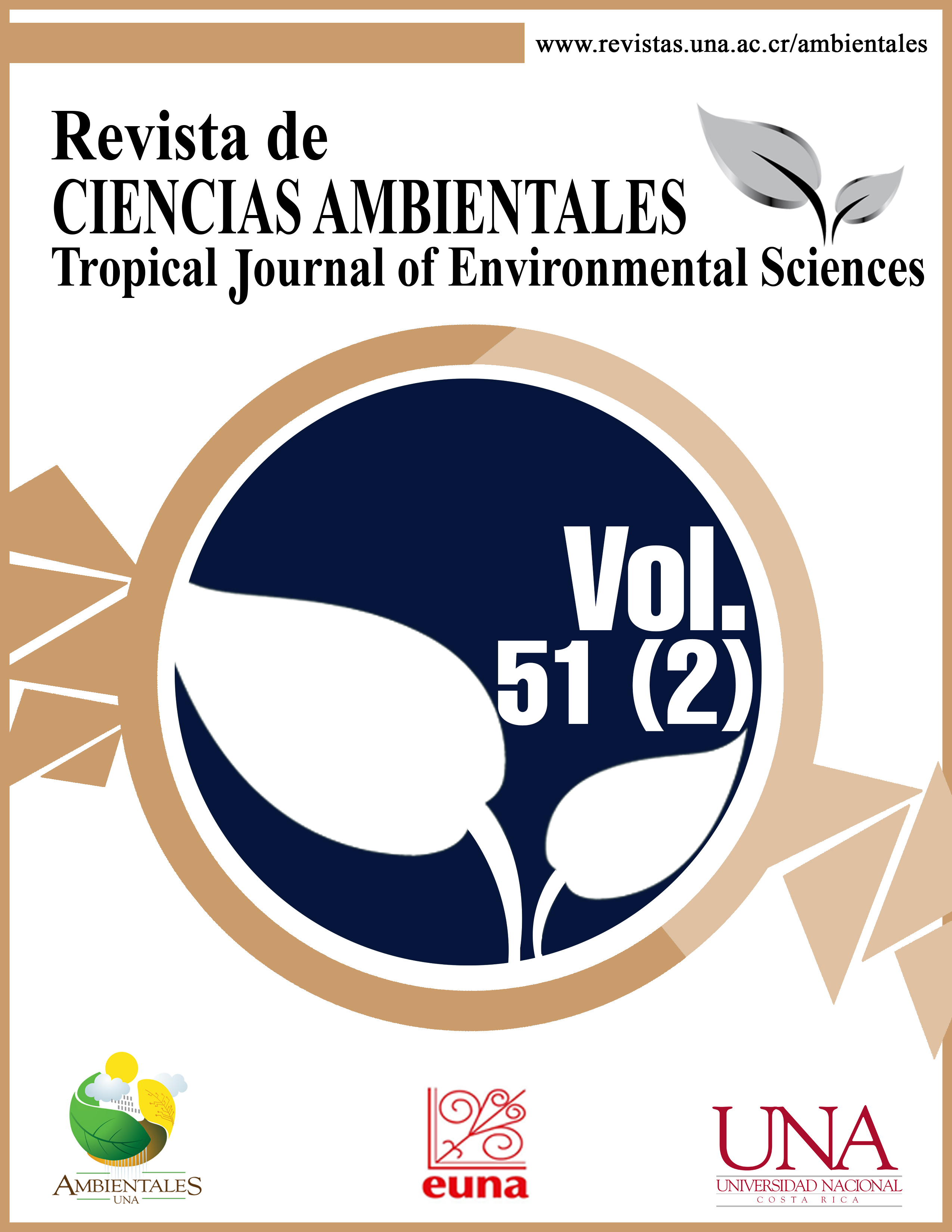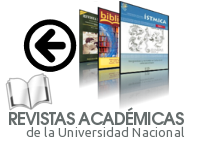¿Do Mountain Microorganisms (MM) Really Work as a Biofertilization Strategy? A Biosystems Engineering Approach
DOI:
https://doi.org/10.15359/rca.51-2.7Keywords:
Bioferment, biosystem, cilantro, soil matrix, spinach, sustainability.Abstract
The use of microorganisms for engineering applications, in particular from a context of tropical biosystems engineering, has been useful to quantify important variables that are needed to understand the dynamics of edaphic systems in these areas. The current study is framed within those efforts and has been designed to document the potential of mountain microorganisms for soil biofertilization activities by using a standard experiment with two short-cycle plants. For that, an experiment including three biofertilization irrigation treatments, associated with three retention times in a bioreactor, were selected and compared with a control that was irrigated only with water. After harvesting, a series of biological, chemical, structural, and agronomic tests were conducted on both the soil and the cultivated plants to determine potential differences in the effect of the experimental treatments. Results indicated that a bioreactor retention time, close to two weeks, was the best treatment in terms of positive and significant impact on the biological activity, soil chemical properties, and quality of crops. Such significant differences seem to be related with a more active soil biosystem for the associated treatment. This demonstrates that biofertilization with mountain microorganisms works; but it also suggests that a series of engineering parameters should be studied to optimize such low cost and sustainable fertilization method.References
Augé, R. M., Stodola, A. J., Tims, J. E., & Saxton, A. M. (marzo, 2001). Moisture retention properties of a mycorrhizal soil. Plant-Soil Relationships, 230(1), 87-97. doi: https://doi.org/10.1023/A:1004891210871
Brem, A. & Ivens, B. (octubre, 2013). Do Frugal and Reverse Innovation Foster Sustainability? Introduction of a Conceptual Framework. Journal of Technology Management for Growing Economies, 4(2), 31-50. doi: http://doi.org/10.15415/jtmge.2013.42006
Callejas-Rodríguez, R., Rojo-Torres, E., Benavidez-Zabala, C. & Kania-Kuhl, E. (enero/febrero, 2012). Crecimiento y distribución de raíces y su relación con el potencial productivo de parrales de vides de mesa. Agrociencia, 46(1), 23-35.
Castro, L., Murillo, M., Uribe, L., & Mata, R. (diciembre, 2015). Inoculación al suelo con Pseudomonas Fluorescens, Azospirillum Oryzae, Bacillus Subtilis y microorganismos de montaña (MM) y su efecto sobre un sistema de rotación soya-tomate bajo condiciones de invernadero. Agronomía Costarricense, 39(3), 21-36.
Campo-Martínez, A., Acosta-Sánchez, R. L., Morales-Velasco, S. y Prado, F. A. (marzo, 2014). Evaluación de microorganismos de montaña (MM) en la producción de acelga en la Meseta de Popayán. Biotecnología en el Sector Agropecuario y Agroindustrial, 12(1), 79-87.
Chiari, P. F. (2015). Efecto de las raciones verdes inoculadas con microorganismos de montaña en la producción y calidad de leche caprina (Tesis de maestría). Escuela de Posgrado del CATIE, Costa Rica.
Franco-Correa, M. (diciembre, 2009). Utilización de los actinomicetos en procesos de biofertilización. Revista Peruana de Biología, 16(2), 239-242. doi: http://dx.doi.org/10.15381/rpb.v16i2.213
Haapala, R. A., Zhao, F., Camelio, J., Sutherland, J. W., Skerlos, S. J., Dornfeld, D. A., Jawahir, I. S., Clarens, A. F. & Rickli, J. L. (julio, 2013). A Review of Engineering Research in Sustainable Manufacturing. Journal of Manufacturing Science and Engineering, 135(4), 041013. doi: https://doi.org/10.1115/1.4024040
Haddad, M., & Sarkar, D. (setiembre, 2012). Glomalin, a newly discovered component of soil organic matter: Part I - Environmental significance Glomalin, a newly discovered component of soil organic matter : Part I — Environmental significance. Environmental Geoscience, 10(3), 91-8. doi: http://doi.org/10.1306/eg.05020303004
Julca-Otiniano, A., Meneses-Florián, L., Blas-Sevillano, R., & Bello-Amez, S. (abril, 2006). La materia orgánica, importancia y experiencias de su uso en la agricultura. Idesia, 24(1), 49-61. doi: https://doi.org/10.4067/S0718-34292006000100009
Kalema, J. & Chacón, M. (2010). Organic Fertilizers and Bio-ferments. Uganda: Agro Eco Louis Bolk Institute, Eastern Africa Branch.
Kondo S. (2015). Producción agroecológica: Agricultura orgánica I. Documento técnico de PROPA-Oriente. MAG, El Salvador. Recuperado de https://www.jica.go.jp/project/elsalvador/0603028/pdf/production/booklet_01.pdf
Martínez-Trujillo, M., & García-Rivero, M. (abril, 2012). Aplicaciones ambientales de microorganismos inmovilizados. Revista Mexicana de Ingeniería Química, 11(1), 55-73.
Núñez, F. (marzo, 2014). Efectos de la costra microbiótica en algunas propiedades del suelo en el sur de la quebrada Los Barrancos, Valle de Quíbor, Venezuela. Investigaciones Geográficas, 2014(84), 5-19. doi: https://doi.org/10.14350/rig.33959
Reyes I., & Valery, A. (diciembre, 2007). Efecto de la fertilidad del suelo sobre la microbiota y la promoción del crecimiento del maíz (Zea mays L.) con Azotobacter spp. Bioagro, 19(3), 117-126.
Ruiz-Altisent, M. (1991). La ingeniería de los biosistemas: Un reto para el futuro. En L. Rallo Romero & F. Nuez Viñals (Eds.), La horticultura española en la C.E. (pp. 245-247). España: Ediciones de Horticultura.
Smith, S. E., St John, B. J., Smith, F. A., & Bromley, J. L. (junio, 1986). Effects of mycorrhizal infection on plant growth, nitrogen and phosphorus nutrition in glasshouse-grown Allium cepa L. New Phytologist, 103(2), 359-373. doi: https://doi.org/10.1111/j.1469-8137.1986.tb00622.x
Suchini, J. G. (marzo 2012). Innovaciones agroecológicas para una producción agropecuaria sostenible en la región del Trifinio. Serie Técnica # 104. CATIE, Costa Rica. Recuperado de http://orton.catie.ac.cr/repdoc/A10933e/A10933e.pdf
Tencio-Camacho R. (2013). Uso de microorganismos benéficos en la agricultura orgánica o ecológica en Costa Rica. Documento técnico sobre agricultura sostenible. DRCO-MAG, Costa Rica. Recuperado de: http://drco-mag.yolasite.com.
Teklay, T., Nordgren, A., & Malmer, A. (enero, 2006). Soil respiration characteristics of tropical soils from agricultural and forestry land-uses at Wondo Genet (Ethiopia) in response to C, N and P amendments. Soil Biology and Biochemistry, 38(1), 125-133. doi: https://doi.org/10.1016/j.soilbio.2005.04.024
Wittmann, C., & Liao, J. (2017). Industrial Biotechnology: Microorganisms. Alemania: Wiley VCH. doi: https://doi.org/10.1002/9783527807833
Žifčáková, L., Větrovský, T., Howe, A., & Baldrian, P. (octubre, 2015). Microbial activity in forest soil reflects the changes in ecosystem properties between summer and winter. Environmental microbiology, 18(1), 288-301. doi: https://doi.org/10.1111/1462-2920.13026
Downloads
Published
How to Cite
Issue
Section
License

This work is licensed under a Creative Commons Attribution-NonCommercial-ShareAlike 4.0 International License.



















